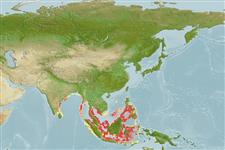Common names from other countries
>
Gobiiformes (Gobies) >
Gobiidae (Gobies) > Gobiinae
Etymology: Trimma: Greek, trimma, -atos = something crushed (Ref. 45335); fucatum: Name from Latin ‘fucatus’, meaning painted, coloured, or rouged; referring to the red markings on and around the preopercle..
More on authors: Winterbottom & Southcott.
Environment: milieu / climate zone / depth range / distribution range
Ecologia
marinhas associadas(os) a recifes; intervalo de profundidade 0 - 23 m (Ref. 59340). Tropical
Indo-West Pacific: Andaman Sea, Phuket, Thailand, Myanmar and Indonesia.
Tamanho / Peso / Idade
Maturity: Lm ? range ? - ? cm
Max length : 2.0 cm SL macho/indeterminado; (Ref. 59340)
Descrição suscinta
Chaves de identificação | Morfologia | Morfometria
Espinhos dorsais (total) : 7; Raios dorsais (total) : 7 - 9; Espinhos anais: 1; Raios anais : 7 - 8. This species is distinguished by having predorsal scales; second and third dorsal spines not elongated; with interorbital and postorbital trenches; opercular scales 2; a single dichotomous branch in the fifth pelvic-fin ray; when alive has three or four rows of yellow to orange blotches along the body and a narrow red bar on the vertical limb of the preopercle (Ref. 59340); characterized further by having longitudinal scale series 21-25; predorsal scales 4-5; cheek without scales; depth of body 4.3 in SL (Ref. 90102).
Collected specimens came from patch reefs and coral slopes with diverse coral cover, except for the 3 specimens collected from a steep (45°) wall of large boulders with little algal or coral growth (Ref. 59340).
Ciclo de vida ou comportamento de acasalamento
Maturities | Reprodução | Spawnings | Egg(s) | Fecundities | Larvas
Winterbottom, R. and L. Southcott, 2007. Two new species of the genus Trimma (Percomorpha: Gobioidei) from western Thailand. aqua, Int. J. Ichthyol. 13(2):69-76. (Ref. 59340)
Status na Lista Vermelha da UICN (Ref. 130435)
CITES (Ref. 128078)
Not Evaluated
Ameaça para os humanos
Harmless
Uso pelos humanos
Ferramentas
Relatórios especiais
Baixar XML
Fontes da internet
Estimates based on models
Preferred temperature (Ref.
115969): 28.6 - 29.3, mean 29 (based on 446 cells).
Índice de diversidade filogenética (Ref.
82804): PD
50 = 0.5000 [Uniqueness, from 0.5 = low to 2.0 = high].
Bayesian length-weight: a=0.01023 (0.00477 - 0.02194), b=3.02 (2.84 - 3.20), in cm Total Length, based on LWR estimates for this (Sub)family-body shape (Ref.
93245).
Resiliência (Ref.
120179): Elevada, tempo mínimo de duplicação da população menor que 15 meses (Preliminary K or Fecundity.).
Fishing Vulnerability (Ref.
59153): Low vulnerability (10 of 100).
